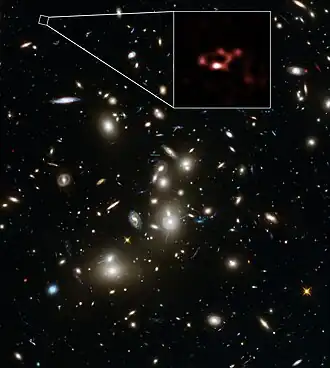A2744 YD4
| A2744_YD4 | |
|---|---|
 Image of A2744 YD4 taken with the Hubble Space Telescope | |
| Observation data (J2000 epoch) | |
| Constellation | Sculptor |
| Right ascension | 00h 14m 24.927s[1] |
| Declination | −30° 22′ 56.15″[1] |
| Redshift | 8.38 [2] |
| Distance | 13.2 billion light years (light-travel distance) |
| Other designations | |
| [ZSM2014] YD4 | |
A2744_YD4 is a very distant young galaxy. This galaxy has first been identified as a possible distant galaxy in 2015 using the Hubble Space Telescope. This detection was made possible because this galaxy lies behind the massive galaxy cluster Abell 2744. In 2017, ALMA observed it and detected a small quantity of dust (the most distant stardust to date) and the first signature of Oxygen emitting light only 600 million years after the Big Bang.[3]
References
- ^ a b Zheng, W.; et al. (2014). "Young Galaxy Candidates in the Hubble Frontier Fields. I. Abell 2744" (PDF). The Astrophysical Journal. 795 (1): 93. arXiv:1402.6743. Bibcode:2014ApJ...795...93Z. doi:10.1088/0004-637X/795/1/93. hdl:10261/110433. S2CID 26253419.
- ^ Laporte, N.; Ellis, R. S.; Boone, F.; Bauer, F. E.; Quénard, D.; Roberts-Borsani, G. W.; Pelló, R.; Pérez-Fournon, I.; Streblyanska, A. (March 2017). "Dust in the Reionization Era: ALMA Observations of a z = 8.38 Gravitationally Lensed Galaxy". The Astrophysical Journal Letters. 837 (2): L21. arXiv:1703.02039. Bibcode:2017ApJ...837L..21L. doi:10.3847/2041-8213/aa62aa. ISSN 2041-8205.
- ^ "Ancient Stardust Sheds Light on the First Stars - Most distant object ever observed by ALMA". European Southern Observatory. 8 March 2017. Retrieved 9 March 2017.